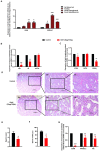Possible Role of GnIH as a Novel Link between Hyperphagia-Induced Obesity-Related Metabolic Derangements and Hypogonadism in Male Mice
- PMID: 35897643
- PMCID: PMC9332143
- DOI: 10.3390/ijms23158066
Possible Role of GnIH as a Novel Link between Hyperphagia-Induced Obesity-Related Metabolic Derangements and Hypogonadism in Male Mice
Abstract
Gonadotropin-inhibitory hormone (GnIH) is a reproductive inhibitor and an endogenous orexigenic neuropeptide that may be involved in energy homeostasis and reproduction. However, whether GnIH is a molecular signal link of metabolism and the reproductive system, and thus, regulates reproductive activity as a function of the energy state, is still unknown. In the present study, we investigated the involvement of GnIH in glycolipid metabolism and reproduction in vivo, and in the coupling between these two processes in the testis level. Our results showed that chronic intraperitoneal injection of GnIH into male mice not only increased food intake and altered meal microstructure but also significantly elevated body mass due to the increased mass of liver and epididymal white adipose tissue (eWAT), despite the loss of testicular weight. Furthermore, chronic intraperitoneal administration of GnIH to male mice resulted in obesity-related glycolipid metabolic derangements, showing hyperlipidemia, hyperglycemia, glucose intolerance, and insulin resistance through changes in the expression of glucose and lipid metabolism-related genes in the pancreas and eWAT, respectively. Interestingly, the expression of GnIH and GPR147 was markedly increased in the testis of mice under conditions of energy imbalance, such as fasting, acute hypoglycemia, and hyperglycemia. In addition, chronic GnIH injection markedly inhibited glucose and lipid metabolism of mice testis while significantly decreasing testosterone synthesis and sperm quality, inducing hypogonadism. These observations indicated that orexigenic GnIH triggers hyperphagia-induced obesity-related metabolic derangements and hypogonadism in male mice, suggesting that GnIH is an emerging candidate for coupling metabolism and fertility by involvement in obesity and metabolic disorder-induced reproductive dysfunction of the testes.
Keywords: GnIH; food intake; glucose and lipid metabolism; reproduction; testis.
Conflict of interest statement
The authors declare no conflict of interest.
Figures




Similar articles
-
Peripheral Gonadotropin-Inhibitory Hormone (GnIH) Acting as a Novel Modulator Involved in Hyperphagia-Induced Obesity and Associated Disorders of Metabolism in an In Vivo Female Piglet Model.Int J Mol Sci. 2022 Nov 12;23(22):13956. doi: 10.3390/ijms232213956. Int J Mol Sci. 2022. PMID: 36430435 Free PMC article.
-
Peripheral 5-HT Mediates Gonadotropin-Inhibitory Hormone-Induced Feeding Behavior and Energy Metabolism Disorder in Chickens via the 5-HT2C Receptor.Neuroendocrinology. 2024;114(8):749-774. doi: 10.1159/000539238. Epub 2024 May 8. Neuroendocrinology. 2024. PMID: 38718758
-
RFRP-3, the Mammalian Ortholog of GnIH, Is a Novel Modulator Involved in Food Intake and Glucose Homeostasis.Front Endocrinol (Lausanne). 2020 Apr 9;11:194. doi: 10.3389/fendo.2020.00194. eCollection 2020. Front Endocrinol (Lausanne). 2020. PMID: 32328034 Free PMC article.
-
Gonadotropin-inhibitory hormone (GnIH): A new key neurohormone controlling reproductive physiology and behavior.Front Neuroendocrinol. 2021 Apr;61:100900. doi: 10.1016/j.yfrne.2021.100900. Epub 2021 Jan 12. Front Neuroendocrinol. 2021. PMID: 33450199 Review.
-
The involvement of gonadotropin inhibitory hormone and kisspeptin in the metabolic regulation of reproduction.J Endocrinol. 2015 May;225(2):R49-66. doi: 10.1530/JOE-14-0688. J Endocrinol. 2015. PMID: 25957191 Review.
Cited by
-
GnIH secreted by green light exposure, regulates bone mass through the activation of Gpr147.Bone Res. 2025 Jan 21;13(1):13. doi: 10.1038/s41413-024-00389-7. Bone Res. 2025. PMID: 39837853 Free PMC article.
-
Peripheral Gonadotropin-Inhibitory Hormone (GnIH) Acting as a Novel Modulator Involved in Hyperphagia-Induced Obesity and Associated Disorders of Metabolism in an In Vivo Female Piglet Model.Int J Mol Sci. 2022 Nov 12;23(22):13956. doi: 10.3390/ijms232213956. Int J Mol Sci. 2022. PMID: 36430435 Free PMC article.
-
Testicular fat deposition attenuates reproductive performance via decreased follicle-stimulating hormone level and sperm meiosis and testosterone synthesis in mouse.Anim Biosci. 2024 Jan;37(1):50-60. doi: 10.5713/ab.23.0175. Epub 2023 Aug 28. Anim Biosci. 2024. PMID: 37641828 Free PMC article.
-
Metabolic Regulation by the Hypothalamic Neuropeptide, Gonadotropin-Inhibitory Hormone at Both the Central and Peripheral Levels.Cells. 2025 Feb 12;14(4):267. doi: 10.3390/cells14040267. Cells. 2025. PMID: 39996740 Free PMC article. Review.
References
-
- Hart R.J., Doherty D.A., Mori T.A., Adams L.A., Huang R.C., Minaee N., Handelsman D.J., McLachlan R., Norman R.J., Dickinson J.E., et al. Features of the metabolic syndrome in late adolescence are associated with impaired testicular function at 20 years of age. Hum. Reprod. 2019;34:389–402. doi: 10.1093/humrep/dey371. - DOI - PubMed
MeSH terms
Substances
Grants and funding
LinkOut - more resources
Full Text Sources
Medical

